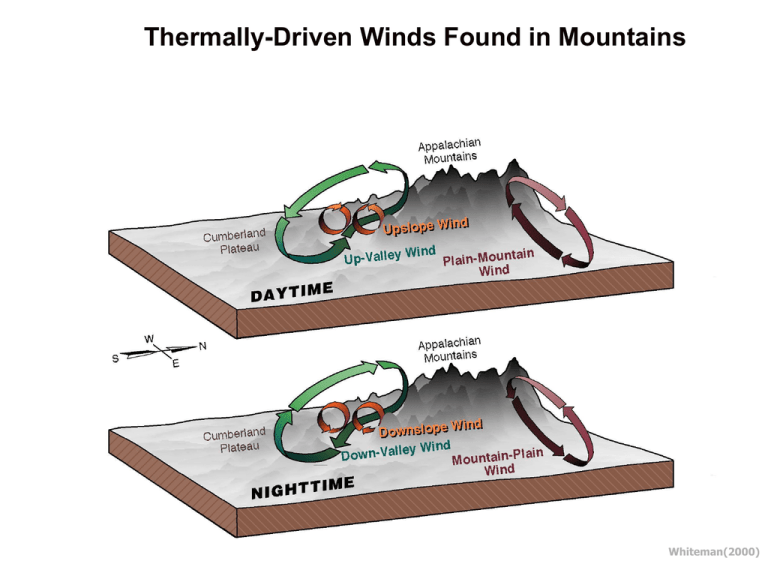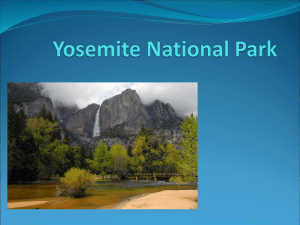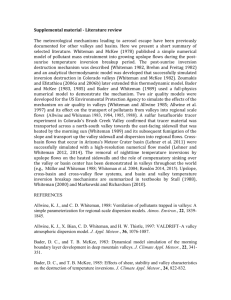Mountain_Met_280_Lecture_11
advertisement

Thermally-Driven Winds Found in Mountains Whiteman(2000) Valley Winds Cross-section of a Mountain Valley Whiteman(2000) Observations Up-Valley and Down-Valley Surface Winds (Measured in Yosemite National Park) Date and Time Valley Winds Daytime: Air is warmer in the valley than over the plain Up-Valley Winds Pressure is lower in the valley and higher over the plain at the same elevation The pressure gradient force is directed from the plain to the valley A up-valley wind is produced that blows from the plain into the valley. Down-Valley Winds Nighttime: Pressure gradient force reverses direction A down-valley wind occurs Whiteman(2000) Valley Exit Jets Whiteman(2000) Valley Exit Jets Whiteman(2000) Observations Time-Height SODAR Wind Profiles 12 August 2003 Vertical Structure of Down-Valley Winds Yosemite National Park, 12 Aug. 2003 Wind minimum ‘Nose’ of Down-valley wind Nose is location of Wind speed maximum Valley wind strength frequency (Whiteman 1990) Equations for the Valley Wind System Q * u v w (u ) (v ) ( w ) t x y z x y z z u u u u p u v w F t x y z x dp gdz p RT u v w 0 x y z p RT Whiteman(1990) The Volume Effect of Valleys Whiteman(2000) Examples of Valley Shapes Whiteman(2000) Topographic Amplification Factor (TAF) Axy valley h Vvalley Axy plain h V plain W Ayzvalley W Ayz plain (Whiteman 1990) Draining vs. Pooling Width to cross sectional area for draining and pooling valley. Draining valleys: W/A decreases with downvalley distance. Ratio increases in pooling valleys. (Whiteman 1990) Conceptual wind models for mountain valleys (Whiteman 1982) Yosemite Valley, Yosemite National Park Mass conservation in a valley Mass Flux in Valley Wind (Yosemite 1998) h M ( z )a( z )u ( z )dz i aiui zi 0 i Where h is the valley depth, is air density at height, a is the valley width, and u is the up-valley component of wind speed. Mass fluxes were computed for individual layers, i of depth z, assuming a constant valley width of a =1000 m. From the vertical wind profiles, the mass fluxes are extrapolated from the top of the profiles (~ 500 m) to the rim height of the valley (~1000 m AGL). Mass Flux in Valley Wind Yosemite Valley (Yosemite 1998) 1000 900 0955 PST 800 Height (m AGL) Profiles of mass flux show that a maximum occurs at ~ 200 m AGL with the development of the up-valley wind at 1035 PST. Up-valley winds in Yosemite Valley may produce total mass fluxes of ~ 5.0 x 10 8 kg h-1. This estimate may lead to a better approximation of pollutant transport into the valley atmosphere. 700 600 500 1035 PST 400 300 200 100 0 0x100 1x104 2x104 3x104 4x104 Mass Flux (kg s -1 ) 5x104 Tethersonde Profiles from Yosemite Valley 700 600 600 PST 630 Height (m AGL) 500 700 400 300 200 725 955 1035 100 0 282 284 286 288 290 292 294 296 298 Potential Temperature (K) 2 3 4 5 6 7 8 Mixing Ratio(g kg-1) -6 -4 -2 0 2 4 6 Up-valley Wind Component (m s-1) Boundary-Layer Evolution: Lee Vining Canyon, 5-6 June 1998 600 Downvalley 2050 PST 500 2116 Upvalley 045 400 117 Height (m AGL) 300 200 100 0 298 300 302 304 306 308 5 5.5 6 6.5 -5 -4 -3 -2 -1 0 1 2 3 4 5 4 5 600 405 PST 500 Downvalley 435 Upvalley 502 400 702 300 755 200 100 0 298 300 302 304 306 Potential Temperature (K) 308 5 5.5 6 Mixing Ratio(g 6.5 kg-1) -5 -4 -3 -2 -1 0 1 2 3 Up-valley Wind Component (m s-1) Inversion destruction Models in mountain Valleys (Whiteman 1982): Pattern 1 Inversion destruction Models in mountain Valleys (Whiteman 1982): Pattern 2 Inversion destruction Model in mountain Valleys (Whiteman 1982): Pattern 3 Diurnal Temperature Evolution in Mountain Valleys (from Stull 1988; adapted from Whiteman 1982) A Simplified Heat Budget of the Valley Atmosphere ˆ )dz (u )dz dz u dz ( R t Tc p Term 1: local rate of change of potential temperature Term 2: convergence of potential temperature flux by mean wind Term 3: convergence of radiative flux Term 4: convergence of turbulent sensible heat flux The thermodynamic model developed by Whiteman and McKee (1982): dh Ao S f (t ) dt T c ph 2 h hi 2 Ao A1 T c p cos t ti 1 1 2 Modeled Inversion destruction 800 1.46 700 (a) 600 1.78 1.86 500 2.25 6.31 400 7.43 300 200 100 0 0 1 2 3 4 5 6 7 Time after sunrise (Hour) 8 9 10 11 800 (b) 700 600 500 1.46 400 1.78 300 1.86 2.25 200 6.31 100 7.43 0 0 0.5 1 1.5 2 2.5 Time after sunrise (hour) 3 3.5 4 Inversion breakup according to Eq. 2 with Ao = 0.45, (a) = 0.007 K m-1 and (b) = 0.015 K m-1 TAF () values are indicated in legend. Diurnal Evolution of the Boundary Layer over Mountains Whiteman(2000) Do valley winds always follow the classic understanding in all mountain areas? Do winds always flow up valley during the day and down valley during the night? Of course not! One example is the Washoe Zephyr wind system. Surface wind roses at each site Frequency distributions of winds from the southwest to northwest quadrant as a function of year and hour of day for (a) all seasons. Frequency distributions of winds from the southwest to northwest quadrant as a function of year and hour of day for (b) the summer season. Frequency distributions of westerly winds 5 ms1 at Galena for each hour of the day for all seasons and for 2003–05 (top) Difference of sea level pressure between Sacramento and Reno, (second from top) 700-mb wind speed and direction from Reno soundings at 0000 UTC on each day, and surface westerly downslope wind for each hour of the day for (third from top) Reno and (bottom) Lee Vining for summer of 2003. RAMS simulated wind speed and (c),(d) potential temperature on an east–west cross section through the center of the domain at (left) 1200 and (right) 2000 LST. Findings Washoe Zephyr is generally not caused by downward momentum transfer as the deep afternoon convective boundary layer on the lee slope of the Sierra Nevada and in the Great Basin penetrates into the layer of westerlies aloft. Instead, the difference in elevation between the elevated, semi-arid Great Basin on the eastern side and the lower region on the western side of the Sierra Nevada provides a source of asymmetric heating across the mountain range. The asymmetric heating evolves during daytime, generating a regional pressure gradient that allows air from the west to cross over the crest and to flow down the eastern slope in the afternoon. Although a westerly ambient wind is not necessary for the development of Washoe Zephyr, its presence leads to strong Washoe Zephyr events that start earlier in the afternoon and that last longer. Summary In mountainous regions, local wind systems develop in response to local heating of the terrain. The winds in these areas are ‘usually’ classified as: Valley winds Slope winds And there are special cases when the winds blow differently than Expected.











